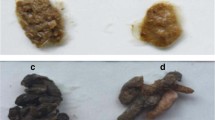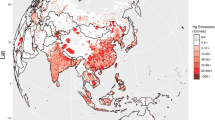Abstract
The aim of the present study was to investigate the effects of high doses of copper (Cu) and mercury (Hg) on the cecal microbiota in female mice. Forty-eight Kunming mice were randomly divided into the control group (CCk group), the Cu group (CCu group), the Hg group (CHg group), and the Cu + Hg group (CCH group). At the 90th day, cecal tissues were prepared for histopathological analysis and cecal contents for analysis by 16S rRNA sequencing method. Cecal tissues from treatment groups had histopathological lesions including increased thickness of inner muscularis and outer muscularis, widened submucosa, decreased goblet cells, mild to moderate necrosis of enterocytes, blunting of intestinal villi, and severe atrophy of central lacteal. Furthermore, compared to the CCk group, the abundance of bacteria genera Rikenella, Jeotgailcoccus, and Staphylococcus were significantly decreased, whereas the bacteria genus Corynebacterium was significantly increased in the CCu group. The abundance of bacteria genera of Sporosarcina, Jeotgailcoccus, and Staphylococcus were significantly decreased in the CHg group and CCH group. The bacteria genus Anaeroplasma was significantly increased in the CCH group. The results indicated that high doses of Cu and Hg caused histopathological lesions and changed the diversity of microbiota in the cecum of female mice, which provide a theoretical basis for more accurate assessment of the risk in intestinal diseases caused by Cu and Hg.





Similar content being viewed by others
References
Sun R, Chen L (2016) Assessment of heavy metal pollution in topsoil around Beijing metropolis. PLoS One 11(5):e0155350. https://doi.org/10.1371/journal.pone.0155350
Yang Z, Lu W, Long Y, Bao X, Yang Q (2011) Assessment of heavy metals contamination in urban topsoil from Changchun City, China. J Geochem Explor 108(1):27–38
Duruibe JO, Ogwuegbu MOC (2007) Heavy metal pollution and human biotoxic effects. Int J Phys Sci 2(5):112–118
Huang SH, Weng KP, Lin CC, Wang CC, Lee CT, Ger LP, Wu MT (2017) Maternal and umbilical cord blood levels of mercury, manganese, iron, and copper in southern Taiwan: a cross-sectional study. J Chin Med Assoc 80(7):442–451. https://doi.org/10.1016/j.jcma.2016.06.007
Lee J, Prohaska JR, Thiele DJ (2001) Essential role for mammalian copper transporter Ctr1 in copper homeostasis and embryonic development. Proc Natl Acad Sci U S A 98(12):6842–6847. https://doi.org/10.1073/pnas.111058698
Uriu-Adams JY, Keen CL (2005) Copper, oxidative stress, and human health. Mol Asp Med 26(4–5):268–298. https://doi.org/10.1016/j.mam.2005.07.015
Malinak CM, Hofacre CC, Collett SR, Shivaprasad HL, Williams SM, Sellers HS, Myers E, Wang YT, Franca M (2014) Tribasic copper chloride toxicosis in commercial broiler chicks. Avian Dis 58(4):642–649. https://doi.org/10.1637/10864-051514-Case.1
Wang XY, Lin RC, Dong SF, Guan J, Sun L, Huang JM (2017) Toxicity of mineral Chinese medicines containing mercury element. China J of Chinese Materia Med 42(7):1258–1264. https://doi.org/10.19540/j.cnki.cjcmm.20170224.002
Li Z, Ma Z, van der Kuijp TJ, Yuan Z, Huang L (2014) A review of soil heavy metal pollution from mines in China: pollution and health risk assessment. Sci Total Environ 468–469:843–853. https://doi.org/10.1016/j.scitotenv.2013.08.090
Funabashi H (2010) Minamata disease and environmental governance (environmental governance in Japan). Int J Jpn Sociol 15(1):7–25
De Filippo C, Cavalieri D, Di Paola M, Ramazzotti M, Poullet JB, Massart S, Collini S, Pieraccini G, Lionetti P (2010) Impact of diet in shaping gut microbiota revealed by a comparative study in children from Europe and rural Africa. Proc Natl Acad Sci U S A 107(33):14691–14696. https://doi.org/10.1073/pnas.1005963107
Villanueva-Millan MJ, Perez-Matute P, Oteo JA (2015) Gut microbiota: a key player in health and disease. A review focused on obesity. J Physiol Biochem 71(3):509–525. https://doi.org/10.1007/s13105-015-0390-3
Lee WJ, Hase K (2014) Gut microbiota-generated metabolites in animal health and disease. Nat Chem Biol 10(6):416–424. https://doi.org/10.1038/nchembio.1535
Breton J, Daniel C, Dewulf J, Pothion S, Froux N, Sauty M, Thomas P, Pot B, Foligne B (2013) Gut microbiota limits heavy metals burden caused by chronic oral exposure. Toxicol Lett 222(2):132–138. https://doi.org/10.1016/j.toxlet.2013.07.021
Balkrishna AP (2011) The effect of heavy metals on the gastrointestinal microflora (GIM) of metapenaus monoceros and fenneropenaeus indicus. AJMBES Journal 13(1):119–124
Mickėnienė L, Šyvokienė J (1999) The effect of heavy metals on microorganisms of digestive tract of crayfish. Acta Zoologica Lituanica 9(2):37–39
Mitra S, Keswani T, Ghosh N, Goswami S, Datta A, Das S, Maity S, Bhattacharyya A (2013) Copper induced immunotoxicity promote differential apoptotic pathways in spleen and thymus. Toxicology 306:74–84. https://doi.org/10.1016/j.tox.2013.01.001
Wildemann TM, Siciliano SD, Weber LP (2016) The mechanisms associated with the development of hypertension after exposure to lead, mercury species or their mixtures differs with the metal and the mixture ratio. Toxicology 339:1–8. https://doi.org/10.1016/j.tox.2015.11.004
Caporaso JG, Kuczynski J, Stombaugh J, Bittinger K, Bushman FD, Costello EK, Fierer N, Pena AG, Goodrich JK, Gordon JI, Huttley GA, Kelley ST, Knights D, Koenig JE, Ley RE, Lozupone CA, McDonald D, Muegge BD, Pirrung M, Reeder J, Sevinsky JR, Turnbaugh PJ, Walters WA, Widmann J, Yatsunenko T, Zaneveld J, Knight R (2010) QIIME allows analysis of high-throughput community sequencing data. Nat Methods 7(5):335–336. https://doi.org/10.1038/nmeth.f.303
Gill SR, Pop M, Deboy RT, Eckburg PB, Turnbaugh PJ, Samuel BS, Gordon JI, Relman DA, Fraser-Liggett CM, Nelson KE (2006) Metagenomic analysis of the human distal gut microbiome. Science 312(5778):1355–1359. https://doi.org/10.1126/science.1124234
Chen H, Jiang W (2014) Application of high-throughput sequencing in understanding human oral microbiome related with health and disease. Front Microbiol 5:508. https://doi.org/10.3389/fmicb.2014.00508
Magoc T, Salzberg SL (2011) FLASH: fast length adjustment of short reads to improve genome assemblies. Bioinformatics 27(21):2957–2963. https://doi.org/10.1093/bioinformatics/btr507
Edgar RC (2010) Search and clustering orders of magnitude faster than BLAST. Bioinformatics 26(19):2460–2461
DeSantis TZ, Hugenholtz P, Larsen N, Rojas M, Brodie EL, Keller K, Huber T, Dalevi D, Hu P, Andersen GL (2006) Greengenes, a chimera-checked 16S rRNA gene database and workbench compatible with ARB. Appl Environ Microbiol 72(7):5069–5072. https://doi.org/10.1128/AEM.03006-05
White JR, Nagarajan N, Pop M (2009) Statistical methods for detecting differentially abundant features in clinical metagenomic samples. PLoS Comput Biol 5(4):e1000352
Zaura E, Keijser BJ, Huse SM, Crielaard W (2009) Defining the healthy “core microbiome” of oral microbial communities. BMC Microbiol 9(1):259
Segata N, Izard J, Waldron L, Gevers D, Miropolsky L, Garrett WS, Huttenhower C (2011) Metagenomic biomarker discovery and explanation. Genome Biol 12(6):R60. https://doi.org/10.1186/gb-2011-12-6-r60
Tao TY, Liu F, Klomp L, Wijmenga C, Gitlin JD (2003) The copper toxicosis gene product Murr1 directly interacts with the Wilson disease protein. J Biol Chem 278(43):41593–41596. https://doi.org/10.1074/jbc.C300391200
Clarkson TW, Magos L (2006) The toxicology of mercury and its chemical compounds. Crit Rev Toxicol 36(8):609–662. https://doi.org/10.1080/10408440600845619
Schelder S, Zaade D, Litsanov B, Bott M, Brocker M (2011) The two-component signal transduction system CopRS of Corynebacterium glutamicum is required for adaptation to copper-excess stress. PLoS One 6(7):e22143
Su XL, Tian Q, Zhang J, Yuan XZ, Shi XS, Guo RB, Qiu YL (2014) Acetobacteroides hydrogenigenes gen. nov., sp. nov., an anaerobic hydrogen-producing bacterium in the family Rikenellaceae isolated from a reed swamp. Int J Syst Evol Microbiol 64(Pt 9):2986–2991. https://doi.org/10.1099/ijs.0.063917-0
Perera NCN, Godahewa GI, Lee J (2016) Copper-zinc-superoxide dismutase (CuZnSOD), an antioxidant gene from seahorse (Hippocampus abdominalis ); molecular cloning, sequence characterization, antioxidant activity and potential peroxidation function of its recombinant protein. Fish Shellfish Immu 57:386–399
Hwang CS, Rhie GE, Oh JH, Huh WK, Yim HS, Kang SO (2002) Copper- and zinc-containing superoxide dismutase (Cu/ZnSOD) is required for the protection of Candida albicans against oxidative stresses and the expression of its full virulence. Microbiology 148(11):3705–3713
Csire G, Demjén J, Timári S, Várnagy K (2013) Electrochemical and SOD activity studies of copper(II) complexes of bis(imidazol-2-yl) derivatives. Polyhedron 61(5):202–212
Perry JJ, Shin DS, Getzoff ED, Tainer JA (2010) The structural biochemistry of the superoxide dismutases. Biochim Biophys Acta 1804(2):245–262. https://doi.org/10.1016/j.bbapap.2009.11.004
Martins I, Goulart J, Martins E, Morales-Roman R, Marin S, Riou V, Colaco A, Bettencourt R (2017) Physiological impacts of acute cu exposure on deep-sea vent mussel Bathymodiolus azoricus under a deep-sea mining activity scenario. Aquat Toxicol 193:40–49. https://doi.org/10.1016/j.aquatox.2017.10.004
Nies DH (1999) Microbial heavy-metal resistance. Appl Microbiol Biotechnol 51(6):730–750
Solioz M, Odermatt A (1995) Copper and silver transport by CopB-ATPase in membrane vesicles of enterococcus hirae. J Biol Chem 270(16):9217–9221
Osborn AM, Bruce KD, Strike P, Ritchie DA (1997) Distribution, diversity and evolution of the bacterial mercury resistance (mer) operon. FEMS Microbiol Rev 19(4):239–262
Sahlman L, Skarfstad EG (1993) Mercuric ion binding abilities of MerP variants containing only one cysteine. Biochem Biophys Res Commun 196(2):583–588. https://doi.org/10.1006/bbrc.1993.2289
ElSaeed GSM, Maksoud A, Soheir A, Bassyouni HT, Raafat J, Agybi MH (2016) Mercury toxicity and DNA damage in patients with Down syndrome. Med Res J 15(15):22–2622
Funding
This project was supported by the National Natural Science Foundation of China grant (No. 31492266, Beijing, P. R. China) awarded to PL, the Natural Science Foundation of Jiangxi Province grant (No. 20171ACB21026) awarded to PL and the Technology R&D Program of Jiangxi Province grant (No. GJJ170243, Nanchang, P. R. China) awarded to PL.
Author information
Authors and Affiliations
Corresponding authors
Ethics declarations
All animals used in this experiment were approved by the Committee of Animal Welfare. Animal studies and experiments were approved and carried out according to Institutional Animal Care and Use Committee guidelines at College of Animal Science and Technology, Jiangxi Agricultural University.
Conflict of Interest
The authors declare that there are no conflicts of interest.
Additional information
All authors have read the manuscript and agreed to submit it in its current form for consideration for publication in the Journal.
Rights and permissions
About this article
Cite this article
Ruan, Y., Wu, C., Guo, X. et al. High Doses of Copper and Mercury Changed Cecal Microbiota in Female Mice. Biol Trace Elem Res 189, 134–144 (2019). https://doi.org/10.1007/s12011-018-1456-1
Received:
Accepted:
Published:
Issue Date:
DOI: https://doi.org/10.1007/s12011-018-1456-1




